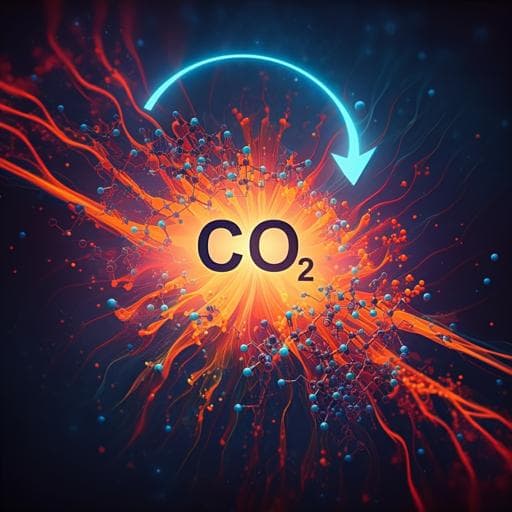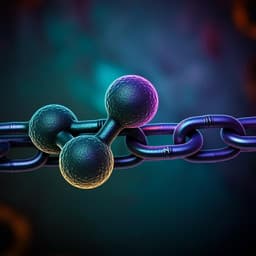
Chemistry
Coverage enhancement accelerates acidic CO₂ electrolysis at ampere-level current with high energy and carbon efficiencies
X. Yu, Y. Xu, et al.
Discover how enhancing CO₂R intermediate coverage can revolutionize formic acid production! This innovative research by Xiaohan Yu and colleagues achieved an impressive 91% Faradaic efficiency, solving the challenges of the competing hydrogen evolution reaction while maintaining high carbon efficiency. A breakthrough for renewable energy-driven chemical synthesis!
~3 min • Beginner • English
Introduction
The study addresses how to achieve selective and energy-efficient electrochemical CO₂ reduction (CO₂R) to liquid products under strongly acidic conditions at industrially relevant current densities. Conventional alkaline or neutral CO₂R suffers from CO₂ loss via carbonate formation, reducing CO₂ utilization efficiency. Operating in strong acid (pH ≤ 1) suppresses carbonate formation but increases proton availability and surface H coverage, which accelerates the competing hydrogen evolution reaction (HER), lowering CO₂R selectivity and energy efficiency. Previous approaches that raise local alkali cation concentration near the electrode can stabilize CO₂R intermediates and hinder proton diffusion, but at high current densities electroconvective turbulence can disrupt cation distributions, and in gas diffusion electrodes alkali cations can precipitate as bicarbonates, hindering CO₂ transport. There is thus a need for catalyst-intrinsic strategies that promote CO₂R over HER in strong acid without relying on mobile cations. The authors hypothesize that enhancing surface coverage of CO₂R intermediates on the catalyst can promote CO₂R while suppressing HER. They propose Cu–Sn alloy catalysts, particularly Cu₆Sn₅, that exhibit strong binding to the OCHO intermediate for formic acid and weak H adsorption, to achieve high selectivity and high single-pass carbon and energy efficiencies in acidic, cation-free systems.
Literature Review
Prior studies have advanced CO₂R via: (1) increasing local alkali cation concentrations to stabilize adsorbed CO₂ and intermediates and impede proton transport; (2) applying micrometer-thick nanoparticle coatings to calm electroconvective flows and maintain steady cation profiles; (3) modifying catalysts with immobilized cationic groups; and (4) adopting cation-free solid-state-electrolyte (SSE)-based membrane-electrode-assembly (MEA) electrolyzers to avoid bicarbonate precipitation. Alloying strategies on Cu (e.g., with Zn, Al, Pb) have been shown to tune intermediate binding, improving selectivity toward multicarbon products or formic acid. Sn, a p-block metal with stronger oxygen affinity and weaker H adsorption than Cu, has been identified as promising for formate production due to favorable OCHO adsorption energies. Despite these advances, achieving high selectivity and energy/carbon efficiency under strong acid at ampere-level current densities remains challenging, motivating this work on Cu–Sn alloys to intrinsically favor OCHO coverage and suppress HER.
Methodology
Computational: Density functional theory (DFT) calculations were performed with VASP using VASPsol implicit solvation plus explicit interfacial water. Grand-canonical DFT within a Constant Electrode Potential (CEP) model was used to capture applied potential and cation effects. Surfaces studied included Cu (111), Cu₀.₈₆Sn₀.₁₄ (111), Cu₆Sn₅ (-113), and Sn (100), chosen as thermodynamically favored facets. Gibbs free energy diagrams for FA and CO pathways were constructed at room temperature, pH 1, and applied potential near -2.1 V vs RHE. Adsorption energies and differential charge densities for key intermediates (*OCHO, *COOH, CO, H) were evaluated. Surface formation energies were computed to assess stability.
Catalyst synthesis: Cu₁₋ₓSnₓ (x = 0.08, 0.14, 0.28, 0.44, 0.71, 0.88), pure Cu, and pure Sn films were fabricated by thermal evaporation onto PTFE gas diffusion electrodes under ~10⁻⁵ Torr, controlling evaporation rates to tune Cu/Sn ratios. Total catalyst thickness was ~800 nm.
Characterization: Morphology and structure were characterized by SEM, TEM, HRTEM, SAED, and STEM-EDX. Phase identification used XRD. XPS was performed for surface chemistry. Surface wettability was assessed via contact angle measurements.
Electrochemical testing in flow cells: Three-electrode flow cells were used under alkaline (1 M KOH, pH 14) and acidic (3 M KCl + 0.05 M H₂SO₄, pH 1) electrolytes. Ag/AgCl reference; Ni foam (alkaline) or Pt (acidic) counter; working electrodes were Cu₁₋ₓSnₓ/Cu/Sn on PTFE (geometric area 0.5 cm²). Anion (Fumasep FAB-PK-130) and proton exchange membranes (Nafion N117) were used as separators. Gas flow was controlled at 25 mL min⁻¹. Product quantification used GC for gases and IC/NMR for liquids. Faradaic efficiencies were calculated from measured product amounts and charge passed; SPCE was determined by carbon balance at specified CO₂ flow rates.
Stability protocol: Galvanostatic tests (including alternating current density sequences) were conducted up to 300 h. To stabilize electrohydrodynamics, a 2–5 μm carbon-Nafion or SiC-Nafion coating was applied on Cu₆Sn₅.
In situ ATR-FTIR: A three-electrode ATR-FTIR cell with Cu₆Sn₅-, Cu-, or Sn-on-PTFE working electrodes in CO₂-saturated 3 M KCl + 0.05 M H₂SO₄ (pH 1) was used to probe surface intermediates across -0.24 to -1.64 V vs RHE. Potassium ferricyanide (5 mM) served as an internal standard to calibrate peak areas, enabling quantitative comparison of OCHO coverage.
SSE-MEA electrolyzer: A cation-free SSE-based MEA comprised Cu₆Sn₅ cathode (area 4 cm²), IrOₓ/Ti foam anode, an AEM (Sustainion X37-50, 50 μm), a CEM (Nafion 117), and a 1 mm-thick solid-state electrolyte (AmberChrom 50WX4, H-form). Anolyte was 0.5 M H₂SO₄. During operation, HCOO⁻ generated at the cathode diffused through the AEM into the SSE and combined with H⁺ from the CEM to form HCOOH, which was flushed out with deionized water. Cell voltages, FEs, and full-cell energy efficiency were monitored over extended operation (up to 130 h).
Key Findings
- Cu₆Sn₅ exhibits strong *OCHO adsorption and weak H adsorption relative to *COOH and H, maximizing FA selectivity while suppressing HER. DFT shows Cu₆Sn₅ (-113) has the largest ΔG between *OCHO and *COOH among Cu, Cu–Sn alloys, and Sn surfaces, and weaker H binding (+0.33 eV vs 1/2 H₂), indicating HER suppression.
- Differential charge density and adsorption energy analyses indicate enhanced charge transfer and highest *OCHO binding on Cu₆Sn₅ (-113), consistent with higher surface *OCHO coverage.
- Introduction of ~14 at.% Sn into Cu weakens CO adsorption to ~0 eV, eliminating pathways to CH₄ and C₂⁺ products; experimentally, C₂ and CH₄ are absent above this Sn content.
- Acidic flow-cell performance (3 M KCl + 0.05 M H₂SO₄, pH 1): Cu₆Sn₅ achieves up to 96% FE for HCOOH at -1.4 V vs RHE and maintains >90% FE from 0.4 to 1.2 A cm⁻². At 1.2 A cm⁻², FA FE is 91%.
- Single-pass carbon efficiency (SPCE) reaches 77.4% at 0.5 A cm⁻² with CO₂ flow of 3 sccm at pH 1, a ~2.8× improvement over a prior report (~27.4% at 0.24 A cm⁻²). FA production remained >70% FE over 300 h at -2.5 V vs RHE; cathodic energy efficiency ~40% at 0.5 A cm⁻².
- In situ ATR-FTIR shows the onset for *OCHO on Cu–Sn is at -0.44 V vs RHE (earlier than Cu or Sn). Calibrated plateau *OCHO peak area on Cu–Sn is ~2.8× that of Sn under identical conditions, evidencing enhanced intermediate coverage.
- Alkaline performance (1 M KOH): CuSn₅ shows >90% formate FE from 0.4 to 1.2 A cm⁻², partial formate current densities up to 1.5 A cm⁻² at ~-1.8 V vs RHE, and stable operation over 120–160 h with >85% FE.
- SSE-MEA electrolyzer: With Cu₆Sn₅ at 100 mA cm⁻², FA FE ~96%, full-cell voltage ~3.7 V, and full-cell energy efficiency >37%. Produced 2.6 L of 0.36 M pure HCOOH over 130 h at a production rate of 5 mL cm⁻² h⁻¹ (20 mL h⁻¹ total), totaling ~700 mmol FA.
- Grand-canonical DFT under operating conditions (pH 1, -2.1 V vs RHE, 3 M K⁺) yields a volcano trend in FA selectivity with Cu₆Sn₅ (-113) at the apex, corroborating experiments.
- Surface formation energetics suggest Cu₆Sn₅ (-113) is more stable than Cu (111), while Sn (100) is less stable, supporting catalyst robustness.
Discussion
The study validates that enhancing the surface coverage of the CO₂R intermediate *OCHO is an effective intrinsic catalyst strategy to boost CO₂R selectivity and activity while suppressing HER under strongly acidic conditions and at high current densities. DFT predicts, and experiments confirm, that Cu₆Sn₅ amplifies *OCHO binding relative to *COOH and H, leading to higher surface *OCHO coverage. This coverage advantage shifts reaction pathways toward formic acid production and away from HER and multicarbon routes, consistent with the disappearance of C₂ and CH₄ products at sufficient Sn content. The approach circumvents limitations of cation-dependent strategies that can be disrupted at high currents or cause bicarbonate precipitation. In acidic flow cells, Cu₆Sn₅ sustains >90% FA FE up to 1.2 A cm⁻² and achieves record SPCE (77.4%) at 0.5 A cm⁻², advancing both CO₂ utilization and energy efficiency. The SSE-MEA demonstrations further highlight practical relevance, yielding pure 0.36 M formic acid over 130 h with >37% full-cell energy efficiency in a cation-free configuration. Collectively, the findings directly address the challenge of selective, efficient acidic CO₂R at ampere-level currents by leveraging intermediate coverage engineering, with implications for scalable, durable CO₂-to-liquid conversion systems.
Conclusion
This work introduces coverage enhancement of key CO₂R intermediates as a catalyst design principle for high-rate acidic CO₂ electrolysis. A Cu₆Sn₅ catalyst with strong *OCHO and weak H binding delivers exclusive formic acid production with >90% FE at 1.2 A cm⁻² and a benchmark single-pass carbon efficiency of 77.4% at 0.5 A cm⁻², maintaining stable operation over 300 h at pH 1. In situ ATR-FTIR quantifies ~2.8× higher *OCHO coverage on Cu₆Sn₅ than on Sn. In a cation-free SSE-MEA, the system produces 2.6 L of 0.36 M pure HCOOH over 130 h with >37% full-cell energy efficiency. These outcomes demonstrate an intrinsic, scalable route to suppress HER and enhance CO₂ utilization in strong acid. Future work could extend coverage engineering to other alloy systems and products, optimize MEA architectures for lower overpotentials and higher energy efficiencies, and investigate long-term durability mechanisms under industry-relevant operation.
Limitations
Related Publications
Explore these studies to deepen your understanding of the subject.







